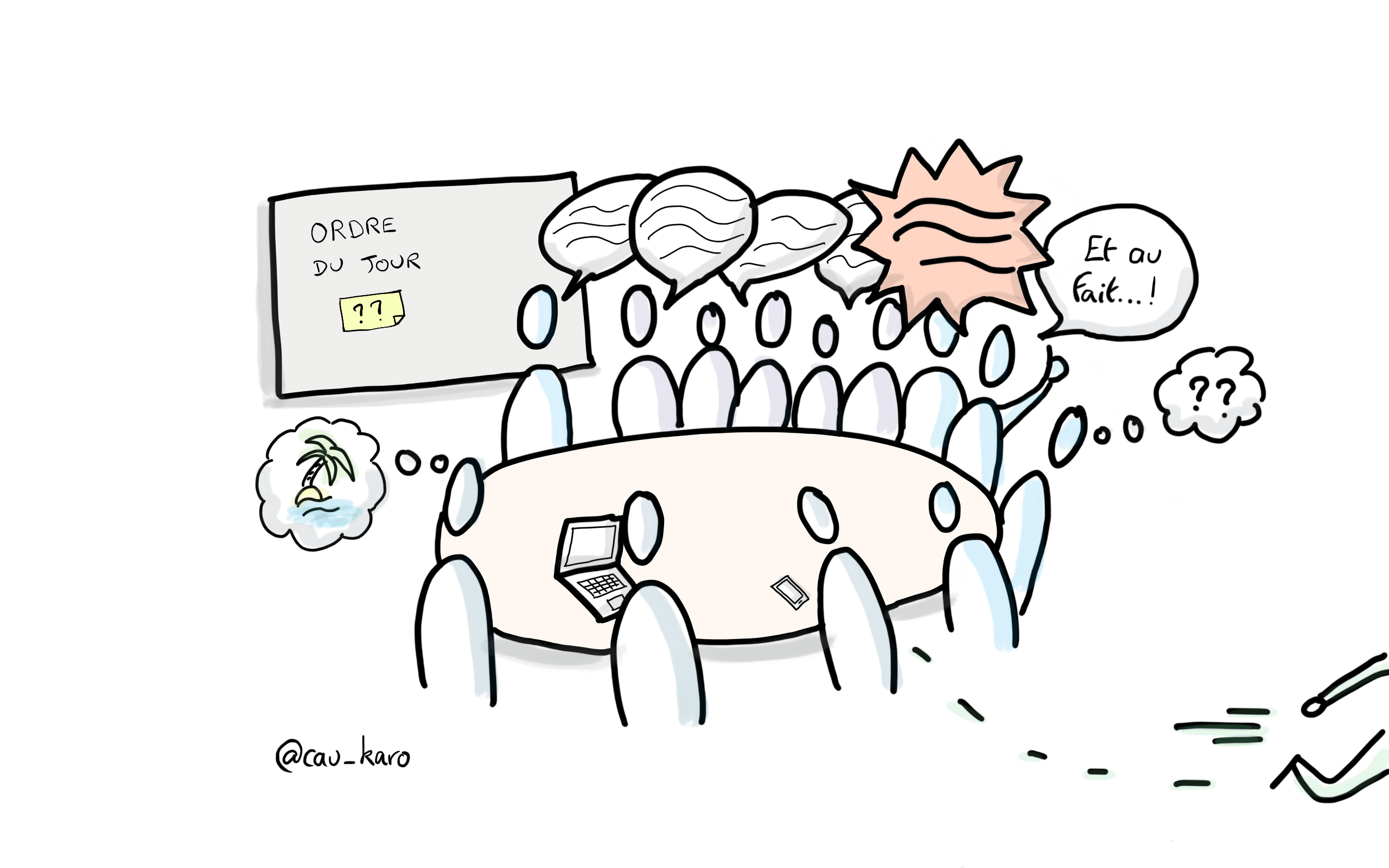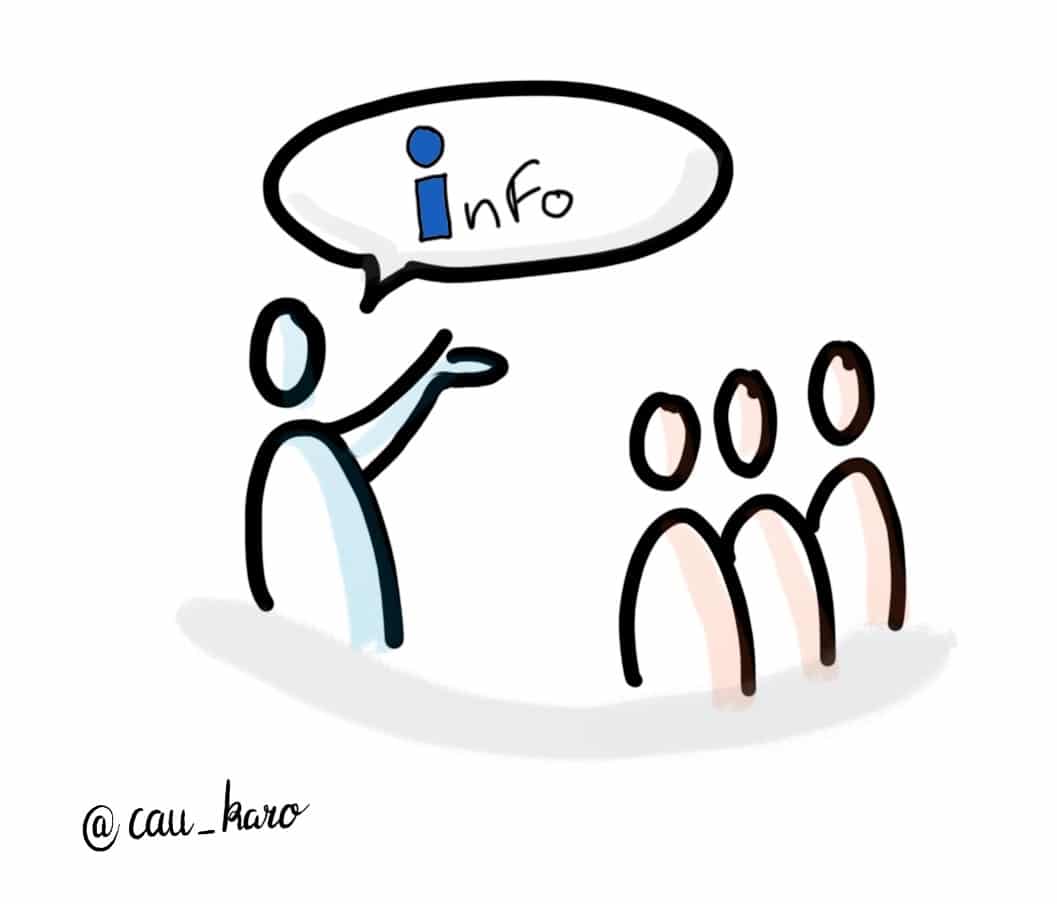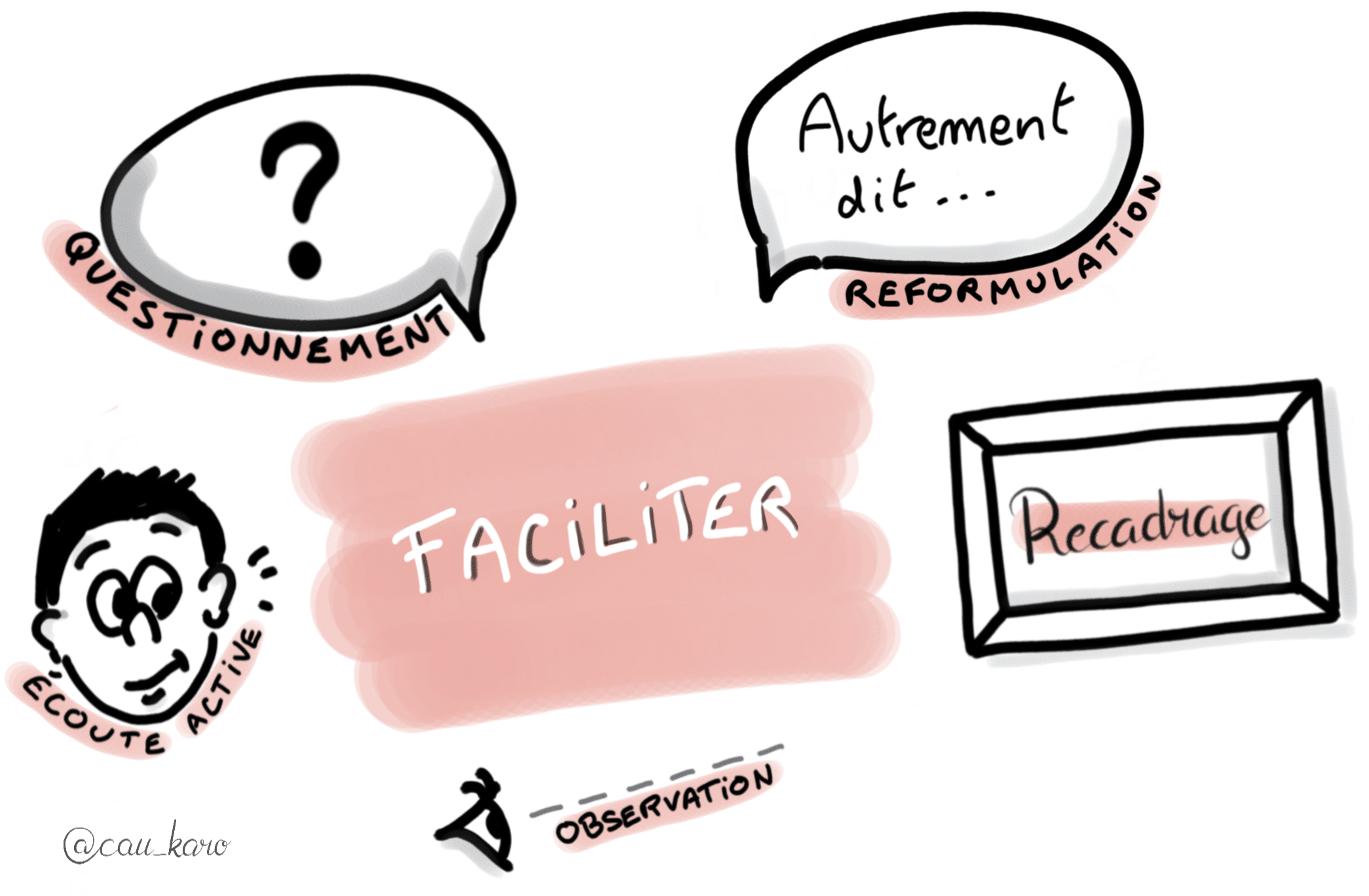La réunionite est un fléau aujourd’hui bien connu en entreprise, et pourtant bien difficile à combattre. J’ai eu l’occasion de participer à un certain nombre d’entre-elles, qui chacune avaient initialement un objectif tout à fait louable, mais dont la forme a pu rendre le tout incroyablement ennuyeux.
C’est lorsque j’ai vu poindre du nez une nième réunion de synchronisation avec plus de 15 personnes que je me suis dit qu’il fallait que je fasse quelque chose pour aider les participants à, si ce n’est à en retirer le maximum de valeur, à perdre le moins de temps possible et aller droit au but !
Je vous propose dans cet article de vous décrire simplement ce que j’ai fait ! 🙂
Contexte
Dans un contexte d’Agilité à l’échelle naissant, la sponsor de la démarche a décidé d’organiser un point de synchronisation de 2h, toutes les semaines, avec l’ensemble des acteurs majeurs des différentes équipes. On y retrouve alors des Managers, des Architectes, des Scrum Masters, des Lead Techs, des Product Owners et d’autres donc je ne me souviens plus du titre. Tout cela pour dire que cela rassemble alors entre 15 et 20 personnes au même endroit – et qui pour la petite histoire, s’avère être une salle faite pour 6 à 8 personnes au tout départ ! 😛
L’intention m’apparaît bonne sachant que l’idée est d’habituer ces différentes personnes à se voir et à échanger sur les sujets ayant un impact sur l’ensemble du groupe. J’y suis d’ailleurs également convié, ce qui me permet d’apprendre à connaître l’éco-système bien plus rapidement.
Ne contribuant pas au contenu des échanges, je m’applique alors à observer attentivement le cours de la session.

- Il n’y a pas véritablement d’ordre du jour mis à part l’objectif d’un point de synchronisation
- La plupart des participants sont sur leurs ordinateurs ou téléphones lorsqu’ils ne prennent pas la parole
- Tout le monde est assis autour de la table et il y a très peu de mouvements pendant la session
- Les discussions peuvent rentrer longuement dans des détails qui ne concernent qu’une petite partie du groupe
- C’est lorsque l’on tente de clôturer la session que certaines personnes se rappellent d’un sujet à aborder, ce qui relance la machine
- L’impression d’une ambiance lourde à certains moments, où les participants apparaissaient comme prisonniers de la réunion, attendant que le glas de la fin résonne.
La timebox de 2h n’a pas été dépassée à mon souvenir mais cela me donnait véritablement l’impression que cela était plus dû à la chance qu’à de l’organisation intentionnelle.
Ainsi, fort de ce constat, j’ai proposé à la sponsor de prendre en main la facilitation de la prochaine réunion de synchronisation – en même temps, je ne fais rien sinon ! 😛
Voici ce que je leur ai proposé lors de cette nouvelle session.
Réflexions et Propositions
Mon intention première était d’introduire un rôle de facilitation dans cette réunion afin de la rendre plus efficace, c’est-à-dire moins longue mais avec les mêmes apports.
Ma réflexion a donc tourné autour de différentes thématiques :
- Comment avoir une meilleure vision des sujets à traiter ?
- Comment avoir les bonnes conversations, au bon moment ?
- Comment garder un rythme soutenable pour maintenir un niveau d’attention suffisant ?
Prenons ces différents sujets un par un :
Comment avoir une meilleure vision des sujets à traiter ?
La chose qui m’a le plus surpris était le fait que l’on ne savait jamais vraiment quand la réunion allait s’arrêter. Aucune visibilité en amont et surtout des interventions de dernières minutes qui retenaient tout le monde à la fin alors que l’attention des personnes étaient déjà sur leur prochaine réunion ou sur leur café à venir.
Ma première réaction fut de me dire :
Autant leur demander d’écrire leurs sujets dès le début de la réunion !
En effet, je crois très peu aujourd’hui (peut-être à tort) que les participants viennent préparés à ce genre de réunion. C’est pourquoi je me suis dis que d’accorder 5 minutes au début pour que chacun se focalise sur les sujets importants à aborder aurait de la valeur.
Maintenant, il fallait rendre ces éléments visibles de tous afin de pouvoir gérer collectivement l’agenda et le rythme. Chaque participant devra donc inscrire sur Post-it chacun des sujets qu’il ou elle souhaite aborder durant cette réunion avec comme règle de base « un sujet, un Post-it » que nous traiterons à l’aide d’un tableau de management visuel.
Le design du board sera le suivant :

- A faire : où l’on déposera tous les sujets à traiter
- En cours : pour expliciter le sujet de la discussion courante
- Actions / Décisions : pour mettre le groupe en action suite à la discussion (si besoin). Chaque action ou décision aura un porteur afin de pouvoir suivre l’impact de cette action / décision.
- Terminé : pour considérer le sujet comme effectivement clos.
| Note : bien sûr, chacun est invité à venir placer lui-même son Post-it sur le tableau afin d’habituer les personnes à se déplacer pendant la session. En effet, il arrivera que des sujets émergent pendant la séance, les personnes auront donc la responsabilité de se lever pour l’ajouter dans la colonne « A faire » du tableau. |
Comment avoir les bonnes conversations, au bon moment ?
Pour répondre à cette problématique, 2 choses me sont apparues comme importantes :
- Différencier les types de sujets
- Jouer mon rôle en tant que facilitateur
Différencier les types de sujets
Dans ma réflexion, j’ai pensé à différencier surtout 2 types de sujets :
| Information | Discussion |

|
 |
| Partage d’informations, la plupart du temps de manière descendante et rapide, ne nécessitant pas véritablement d’échanges ni d’actions. et généralement rapides | Sujets nécessitant réflexion, débat et donc généralement mise en oeuvre d’actions et/ou prise de décisions. |
Ainsi, si je reprends une des règles du GTD (Getting Things Done), il vaut mieux traiter les sujets rapides en premier pour optimiser le traitement de ses tâches. On va donc commencer par l’ensemble des sujets de type Information puis l’on abordera par la suite les sujets de type Discussion. Cela nous permet déjà dans un premier temps de structurer la session collectivement.
Jouer mon rôle en tant que facilitateur

Pour ce faire, j’utiliserais avec parcimonie :
-
- La reformulation : afin de m’assurer que les éléments discutés ont été bien compris par tous (dans la mesure du possible)
- L’écoute active : afin de percevoir les dissonances dans les propos pouvant mettre à mal la dynamique de la session
- Le recadrage : afin d’assurer le partage des différents points de vue sans jugement et le recentrage sur les sujets essentiels
- Le questionnement : afin de m’assurer que les discussions concernent bien les bonnes personnes, au bon moment
- L’observation : afin de m’assurer de l’intérêt du sujet pour le groupe et pour pouvoir distribuer la parole de manière équitable
Comment garder un rythme soutenable pour maintenir un niveau d’attention suffisant ?
Pour ce dernier cas, j’ai considéré que cela faisait en grande partie de mon rôle en tant que facilitateur.
En effet, le rythme de la session sera principalement lié à la qualité de mes interventions au cours des conversations pour reformuler, clarifier et recadrer les propos des participants tout en m’assurant que les sujets soient bien traités et clôturés par une action ou une décision si nécessaire.
Conclusion
Ce mode de facilitation a permis de passer d’un point de synchronisation initial d’une durée de 2h à une durée d’1h tout en traitant l’ensemble des sujets amenés par les participants. Le feedback général est d’ailleurs très positif avec des participants repartant avec le sourire et avec je l’espère, l’impression d’avoir vécu une réunion utile.
Si l’on devait réfléchir en terme de coût, c’est une opération très rentable : non seulement j’ai pu me rendre utile pendant une heure mais une vingtaine de personnes ont pu gagner une heure dans leur agenda ! 😛 Il reste néanmoins toujours difficile de faire décoller les personnes de leurs ordinateurs lorsqu’il y a beaucoup de monde et avec l’attention qui chute dans le temps.
J’ai néanmoins la conviction que c’est un pas supplémentaire vers plus d’interactivité en réunion et que nous avons un vrai rôle à jouer dans ce sens. L’idée serait de pouvoir transmettre ces outils et pratiques à un maximum de personnes et de les transformer non pas en outils gadgets à utiliser de manière exceptionnelle mais plutôt comme de nouvelles habitudes de travail afin de redorer la bannière de ces réunions mal-aimées et pourtant si prisées et ainsi garantir une meilleure performance collective.
N’hésitez pas à tester ces petites choses chez vous si vous ne l’avez pas encore fait et donnez m’en des nouvelles !
Toutes vos astuces sont également les bienvenues 🙂







3 réponses
Constat partagé sur le manque de préparation et d’efficacité. J’ai aussi vécu la supréparation…des 40 slides dont on ne verra que 10 en séance parce qu’on est en retard de toute façon.
Effectivement c’est un moment privilégié pour proposer d’expérimenter d’autres types d’interactions
Jolis scribings 😉
et belle facilitation
Q :
1) Comment priorises-tu les sujets ? y compris ceux arrivant en cours de séance
2) limites-tu (par nombre ou timebox) les sujets de type information ? Pour laisser le temps suffisant aux décisions
3) le début de la séquence « Voir ensemble > Agir ensemble » est bien mis en place. As-tu expérimenté quelque chose pour l' »Apprendre ensemble ? » Qu’ont-ils appris de ta facilitation et de l’expérience ? De leurs réunions ? De leurs sujets ?
Merci pour ce partage et bravo pour l’avancée que tu leur as offert !
Je me posais un peu les mêmes questions que Christophe :
– Comment fais tu pour la priorisation et si tu timeboxe les interventions
– Je me demandais si vous n’étiez pas débordé de sujets ce qui nécessite de voter pour un nombre restreint en votant ?
– Est ce que les sujets de type information génére des discussions qui s’allongent ?
– La sponsor ne peut pas donner comme consigne de venir sans tel et pc ?
Merci et bonne continuation à toi.
Super article Olivier ! Très clair et bien écrit !
Bonne idée d’appliquer un workflow à la réunion, cela rend les participants un peu plus actifs et un bon indicateur d’avancement.
J’ai fait remplacer une réunion hebdomadaire par un suivi de tableau type Kanban, en stand up, de plus d’1h on est passés à 15min ! (avec un meilleur suivi des actions/décisions en prime)
Pour ce qui est des ordinateurs et téléphones, je me fais aider du sponsor pour « forcer » leur fermeture avant la réunion (à faire avec diplomatie et bienveillance bien sûr) ou bien même préciser dans l’invitation que les ordinateurs ne sont pas nécessaires. Le fait de ne pas les avoir réduit souvent les longueurs dont tu parles.
Merci pour l’article !